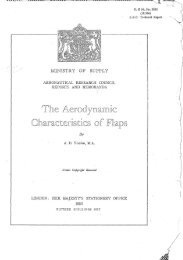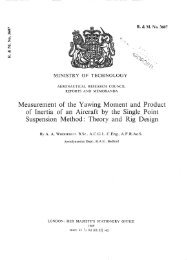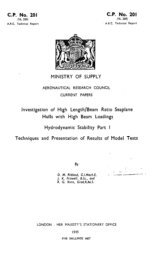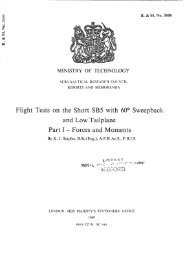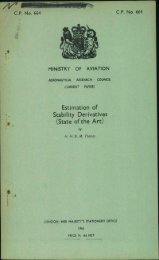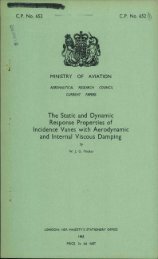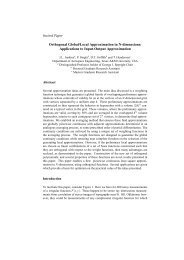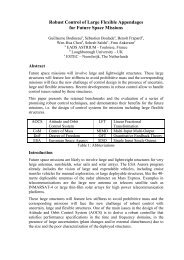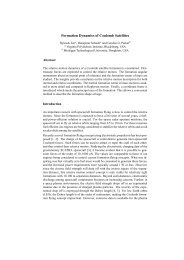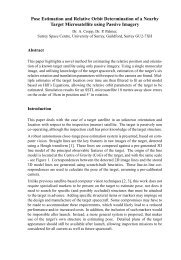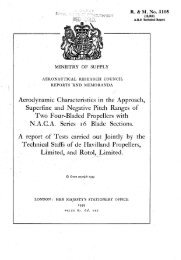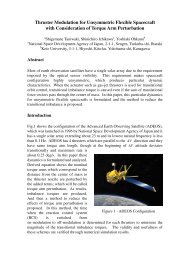A Survey of Unsteady Hypersonic Flow Problems
A Survey of Unsteady Hypersonic Flow Problems
A Survey of Unsteady Hypersonic Flow Problems
You also want an ePaper? Increase the reach of your titles
YUMPU automatically turns print PDFs into web optimized ePapers that Google loves.
- 56 -<br />
mean incidence case; but, for t'he non-linear case, it represents not a speed<br />
above which small disturbances will grow, but the size <strong>of</strong> the a, component <strong>of</strong><br />
s.n unstable limit cycle dscillstion for the corresponding speed. If the section<br />
is flying at a speed corresponding to some horizontal line <strong>of</strong> the figure and<br />
is subjected to a disturbance, the resultant motion <strong>of</strong> the wing will grow if the<br />
amplitude <strong>of</strong> the initial disturbance is greater than the value <strong>of</strong> a, given by<br />
the curve (and b), but it will decay if it is less.<br />
There has been no direct experimental investigation <strong>of</strong> the results <strong>of</strong><br />
this non-linear analysis. In Ref. 61, where the values <strong>of</strong> Mach number would<br />
make non-linear effects likely, some cases <strong>of</strong> limited-amplitude flutter after<br />
a slow initial growth were experienced, and there were other oases where<br />
finite-amplitude initial disturbances were necessary before flutter occurred, but<br />
this behsviour could be the result <strong>of</strong> friction or structural non-linearities.<br />
Ccmparxon <strong>of</strong> Theory and Experiment<br />
The results available suggest that piston theoryffor sharp-nosed<br />
sections may give predictions <strong>of</strong> flutter .ss adequate as other methods up to<br />
M6 and Ma; this is suggested especially by the results<br />
!?G:$gt ~$%6~fwhere ~6~ z 1.5 and ~a, et 1.7.<br />
For blunt nose sections, it can be concluded from Goeta's results 60<br />
that Newtonian theory may be adequate to predict flutter speed, but it can be<br />
used only on an empirical basis; and that the Newtonian-piston theory,suggested<br />
in Ref. 57, is likely to be no more adequate than Newtonian theory in the<br />
simple form proposed - possibly this is because it does not take account <strong>of</strong> the<br />
effects <strong>of</strong> the strong shock wave set up by the blunt nose, since attempts to<br />
take account <strong>of</strong> such effects (Ref. 57 and. Fig. 49) suggest that they reduce the<br />
flutter speed. Both theories e.re conservative in their predictions.<br />
One point emerges from this review which is not strictly relevant to<br />
its purpose, but which it may be useful to make. This is, that it is difficult<br />
to assess the adequacy <strong>of</strong> aerodynamic theories for flutter analyses from<br />
comparisons between experimental results and theoretical. predictions <strong>of</strong> flutter<br />
speed and frequency, because <strong>of</strong> the structural uncertainties in the experimental<br />
conditions. Greater attention needs to be paid to defining these conditions.<br />
Such uncertainties are shown most clearly in Hanson's repor@, where the choice<br />
<strong>of</strong> structural modes to be used in the analysis has e. considerable effect on the<br />
agreement between theory and experiment, but it is no clear which choice is<br />
more appropriate structurally; and in Young‘s report k, , where the level <strong>of</strong><br />
structural damping assumed in the analysis made a very large difference to the<br />
agreement <strong>of</strong> theory and experiment on flutter frequency.<br />
4.2.2 The flutter <strong>of</strong> slender configurations<br />
It was pointed out earlier that flutter <strong>of</strong> the main structure <strong>of</strong> a<br />
hypersonic vehicle was likely to involve chordwise bending modes <strong>of</strong> the dings,<br />
and bending modes <strong>of</strong> the body. Information on flutter <strong>of</strong> these kinds is meagre.<br />
The general forms <strong>of</strong> the equations involved are established in Ref. 62: for<br />
slender bodies they are considered in Chapter 7 and for low aspect ratio lifting<br />
surface flutter with chordwise bending modes in Chapter 8. But the aerodynamic<br />
problems involved tare not examined. What can.be established. from the available<br />
references is that chordwise bending modes can be important in the flutter <strong>of</strong><br />
low aspect ratio surfaces,<br />
o theories must provide adequate<br />
pictures <strong>of</strong> the pressure<br />
and that the free-free flutter <strong>of</strong> a<br />
slender/



